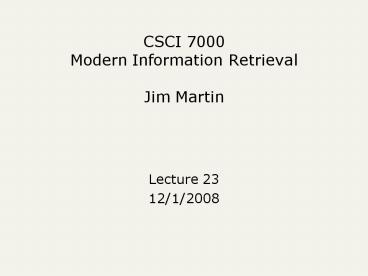CSCI 7000 Modern Information Retrieval Jim Martin PowerPoint PPT Presentation
1 / 22
Title: CSCI 7000 Modern Information Retrieval Jim Martin
1
CSCI 7000Modern Information RetrievalJim Martin
- Lecture 23
- 12/1/2008
2
Today 12/1
- Collaborative Filtering
- Recommender systems
3
Collaborative Filtering
- Filtering in the IR context generally means
separating things (documents) into categories.
That is, classification. - Binary special case
- Yes/No. I care about it or I dont.
- As weve seen its typically done by training
supervised or unsupervised systems based on the
contents of the items being classified. - By contrast, in collaborative filtering its done
by looking primarily at the behavior of other
users.
4
Recommender Systems
- Recommender systems are a specific application of
collaborative filtering. - Recommend a product (movie, book, music, etc.) to
a user based on... - That users past behavior with respect to other
products - Other users behavior with respect to other
products - Behavior here could mean purchases, or could
mean explicit ratings
5
Example CF Technology iTunes Genius
6
Amazon
- Probably the most well-developed system.
- Multiple presentations to the user
- Recommendations for you
- People who bought X also bought Y
- Of the people who looked at X, some bought the
following... - Good recommendations drive sales
7
Netflix Prize
- Improve the Netflix recommender system by 10 and
win 1M.
8
Basic Approach
- You have
- A bunch of items
- A bunch of users
- And data recording users behavior with respect to
the items - Ratings (ordinals or reals)
- Purchases (binary)
- So lets do what always do and make matrix. In
this case - A user x item matrix
9
Basic Approach
- As usual the matrix is mostly empty.
- These empty cells represent opportunities to make
recommendations.
Items
Users
10
Basic Approaches
- Given an User x Item matrix you can take three
basic approaches. - User-based
- Similarity among users
- Item-based
- Similarity among items
- Model-based
- Fill in the missing cells with plausible values
based on the structure of the existing matrix
11
User Based Methods
- For a given user of interest
- Ie. A customer logged in to Amazon
- Compute the similarity of all users to the
current user and select a subset to use as
predictors - Normalize ratings across users
- Make predictions for current user by using a
weighted combination of other user ratings.
12
User-Based Methods
- Pearson correlation
- Ranges from -1 to 1
- 1 means the ratings between users are perfectly
correlated - -1 means theyre perfectly anti-correlated
- 0 means that theres no observable correlation.
13
Item-Based Methods
- For the user of interest, select a subset of
highly rated items from their vector. - Compute the similarity score between those
vectors and other currently empty entries for
that user. - Recommend the N closest unrated entries.
- Basically the same method. Just flips users and
items.
14
Model-Based Methods
- Treat the missing entries like 0s in a language
model, or a probabilistic model. - One approach is to just use LSA to do a
dimensionality reduction on the matrix.
15
Evaluation
- Given a training set, the typical scenario is to
use a held-out scheme - Typically based on holding out a rating, not an
item or a user - For example
- Hold out 1 rating per user (row) and predict the
missing entries. - Compare predicted values to known values.
- Average over the users
- Or
- Sample K ratings per user and predict the missing
values.
16
Datasets
- www.grouplens.org
17
Lots of Issues
- Fundamental problem underlying all of these
approaches and the whole paradigm... - Stationarity assumption
- Basically that things arent changing in ways
that matter with respect to the probabilities in
question - But of course thats silly tastes change and
people change all the time.
18
Lots of Issues
- The current way of casting the problem ignores
the temporal dimension. - A users future behavior is based their past
behavior in funny ways that the current model
doesnt handle well. - For example, it doesnt capture marginal utility.
- How many intro books on a given programming
language does one person need? - The fact that a system might accurately predict
my hypothetical rating of an item is not a
prediction about whether or not I care about that
item at all.
19
Lots of Issues
- In many settings, various kinds of metadata is
available - Demographic information about users (gender, age,
location, etc.) - Information about the products (price, category,
prices of similar items, age, features, etc.) - Incorporating such information into the basic
scheme is problematic.
20
Lots of Issues
- Privacy
- Storing data on user choices is a tricky business
with obvious privacy concerns - Most efforts rely on deidentification
techniques... - Replace any real world identifier with a unique
meaningless term... - But that doesnt always work
- AOL fiasco
- Netflix partially hacked
21
Readings for Collaborative Filtering
- Read Chapter 2 of Collective Intelligence
- And the Adomavicius et al and the McNee et all
papers linked to on the web page.
22
Quiz
- Quiz is Wednesday
- Focus on material since last quiz
- Information extraction
- Sentiment and opinion
- Recommender systems
- But you should remember the earlier stuff
- Retrieval, classification and clustering

